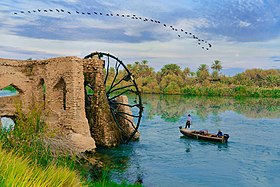
Back محافظة الأنبار Arabic ܐܢܒܐܪ (ܗܘܦܪܟܝܐ) ARC الانبار (محافظه) ARZ Ənbar mühafəzəsi Azerbaijani انبار اوستانی AZB Анбар (мухафаза) Byelorussian Ал Анбар Bulgarian আল আনবার প্রদেশ Bengali/Bangla Governació d'Al-Anbar Catalan Muḩāfaz̧at al Anbār CEB
Al Anbar Province
محافظة الأنبار Anbar Province | |
|---|---|
| Anbar Governorate | |
 | |
| Coordinates: 32°54′N 41°36′E / 32.900°N 41.600°E | |
| Country | |
| Seat | Ramadi |
| Government | |
| • Type | Provincial Government |
| • Body | Council of Anbar Province |
| • Governor | Mohammed Nouri al-Karbouli |
| Area | |
| • Total | 138,501 km2 (53,476 sq mi) |
| • Water | 2,350 km2 (910 sq mi) |
| • Rank | 1st |
| Dimensions | |
| • Length | 113 km (70 mi) |
| • Width | 125 km (78 mi) |
| Elevation | 45 m (148 ft) |
| Highest elevation | 450 m (1,480 ft) |
| Lowest elevation | 35 m (115 ft) |
| Population (July 2018 estimate) | |
| • Total | 1,771,656 |
| • Rank | 7th |
| • Density | 13/km2 (33/sq mi) |
| Time zone | UTC+3 |
| ISO 3166 code | IQ-AN |
| HDI (2021) | 0.680[1] medium |
| Website | anbar |
Al Anbar Governorate (Arabic: محافظة الأنبار; muḥāfaẓat al-’Anbār), or Anbar Province, is the largest governorate in Iraq by area. Encompassing much of the country's western territory, it shares borders with Syria, Jordan, and Saudi Arabia. The population is mostly Sunni Arabs.[2] The provincial capital is Ramadi; other important cities include Fallujah, Al-Qa'im and Haditha.
The governorate was known as Ramadi up to 1976 when it was renamed Al Anbar Province, and it was known as Dulaim before 1962. A large majority of the inhabitants of the province are Arab Sunni Muslims and most belong to the Dulaim tribe.
In early 2014, the Islamic State, with the assistance of some local Sunni militias, launched a successful campaign to seize control of the province from the Iraqi government. Numerous offensive actions were undertaken by the Iraqi government, with the assistance of local Sunni tribes to remove IS's occupation of the province, especially in the Anbar campaign (2015–16), the Western Anbar offensive (September 2017) and the 2017 Western Iraq campaign. The area was effectively recaptured by the end of 2017 and has been at peace since then.
- ^ "Sub-national HDI - Area Database - Global Data Lab". hdi.globaldatalab.org. Retrieved 2018-09-13.
- ^ "Anbar". European Union Agency for Asylum. Retrieved 2024-05-09.





